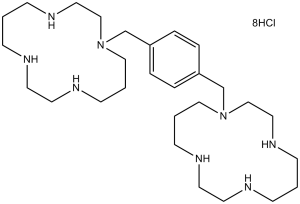This product is for research use only, not for human use. We do not sell to patients.

| Size | Price | Stock |
|---|---|---|
| 250mg | $320 | In Stock |
| 500mg | $500 | In Stock |
| 1g | $750 | In Stock |
Cat #: V1487 CAS #: 155148-31-5 Purity ≥ 98%
Description: Plerixafor 8HCl (formerly JM-3100; AMD-3100; SDZ-SID-791; JLK-169; SID-791; JM-2987; MOZOBIL), the hydrochloride salt of Plerixafor, is a specific chemokine receptor CXCR4 antagonist used as an immunostimulant to mobilize hematopoietic stem cells in cancer patients into the bloodstream.
Publications Citing InvivoChem Products
Product Promise

- Physicochemical and Storage Information
- Protocol
- Related Biological Data
- Stock Solution Preparation
- Quality Control Documentation
| Molecular Weight (MW) | 794.47 |
|---|---|
| Molecular Formula | C28H54N8.8HCl |
| CAS No. | 155148-31-5 |
| Storage | -20℃ for 3 years in powder formr |
| -80℃ for 2 years in solvent | |
| Solubility In Vitro | DMSO:<1 mg/mLr |
| Water: 100 mg/mL (125.9 mM)r | |
| Ethanol: <1 mg/mL | |
| Solubility In Vivo | Saline: 30 mg/mL |
| Synonyms | JM 3100 8HCl; AMD3100; JM 3100; AMD-3100; JM3100; JM-3100; AMD 3100; SDZ-SID-791; JLK-169; SID-791; JM-2987; Plerixafor HCl; MOZOBIL. |
| Protocol | In Vitro | The CXCR4 inhibitor Plerixafor (AMD3100) is a potent inhibitor of CXCL12-mediated chemotaxis (IC50, 5.7 nM) with a potency slightly better than its affinity for CXCR4. Treating the cells with CCX771 or CXCL11 has no effect on CXCL12-mediated MOLT-4 or U937 TEM. In contrast, 10 μM Plerixafor inhibits CXCL12-mediated TEM in both cells lines |
|---|
| Solvent volume to be added | Mass (the weight of a compound) | |||
|---|---|---|---|---|
| Mother liquor concentration | 1mg | 5mg | 10mg | 20mg |
| 1mM | 1.2587 mL | 6.2935 mL | 12.5870 mL | 25.1740 mL |
| 5mM | 0.2517 mL | 1.2587 mL | 2.5174 mL | 5.0348 mL |
| 10mM | 0.1259 mL | 0.6294 mL | 1.2587 mL | 2.5174 mL |
| 20mM | 0.0629 mL | 0.3147 mL | 0.6294 mL | 1.2587 mL |
This equation is commonly abbreviated as: C1 V1 = C2 V2
- (1) Please be sure that the solution is clear before the addition of next solvent. Dissolution methods like vortex, ultrasound or warming and heat may be used to aid dissolving.
- (2) Be sure to add the solvent(s) in order.




































